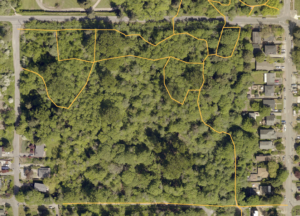Park Profile: Brandon Street Natural Area
Life is a lot quieter this spring as Seattle works and shelters at home. One notable exception is public parks and other outdoor spaces, which have for many become a valuable escape from the indoors. This has led public health officials to warn about large parks becoming overcrowded, and in some cases being closed during high-traffic times. With all that in mind, we’re putting together a series of posts on small neighborhood parks that make for scenic getaways and enable you to keep moving!
Nestled in the shadow of Camp Long and the West Seattle Golf Course, it’s easy to overlook Brandon Street Natural Area. Measuring in at about 10 acres, size is not the issue, but rather the lack of a clear park entrance and the peripheral trails. Still, if you’re able to look past these superficial shortcomings, you’ll find a peaceful gem only blocks from busy Delridge Way.
Brandon Street Natural Area is part of the Longfellow Creek Greenspace, a loosely organized collection of public land from Dragonfly Pavilion in the north to Thistle Street in the south. The natural area is roughly bounded by SW Brandon Street on the north and SW Findlay Street on the south, and 26th Ave SW and 29th Ave SW on the east and west. The primary trail runs alongside Brandon Street, along the south border on the Findlay Street right-of-way, and north-south along the creek itself. The western and central portions of the park, where one of DNDA’s restoration sites is located, are networked only by a few rough social trails.

A restoration site at Brandon Street Natural Area before (top) and after (bottom) removal of invasive bindweed by volunteers in 2019
The restoration areas are most easily accessed from either of the two turnouts on 29th Ave. Both were restricted with concrete ecology blocks in 2019 due to persistent problems with illegal dumping. However, if you’re on foot, the site should be wide open!
Despite our long history in the neighborhood, DNDA has only worked in the park since 2018. For many years prior to that, most of the restoration work in the area was done by King Conservation District, a governmental agency that offers environmental resources and expertise to landowners. Since taking over the work, we have continued to partner with KCD for an annual volunteer restoration event at the site.
Longfellow Creek is a particularly important tributary to the Duwamish River because it is one that still hosts spawning salmon in the fall. The journey for returning salmon in Longfellow Creek ends at the West Seattle Golf Course, which has an impassible barrier for the fish. In addition, forest conditions upstream can impact overall water quality in the creek, affecting the health of the salmon. One of our primary work areas has the designation “IvyTown,” a reference to its historical state of being heavily invaded by English ivy (Hedera spp.)
Ivy is one of the most familiar and widespread invasive plant species in the Pacific northwest, and one of the most common targets of forest restoration practitioners. This is because, while scenic, ivy inhibits regeneration of understory plants and shades out larger shrubs and trees.
Regular visitors to Brandon Street Natural Area may have noticed some new signs posted in recent months requesting feedback on new pathways and signage planned for the area. The area is due for some substantial changes in connection with the new Rapid Ride H project through Delridge. The most visible change will likely be along the north and south edges of the park, as transit organizations try to make it easier for residents to access the bus corridor on Delridge Way. A survey is open until the end of September for anyone interested in shaping the future around this beautiful natural space.

A sign at the intersection of 29th Ave SW and SW Brandon St offering information on planned changes to area
We hope you found this little walkthrough informative and perhaps an enticement to get out of the house. Next month, we will be heading just across the street, to one of our smallest sites – let us know if there’s anything else you would like to learn!


